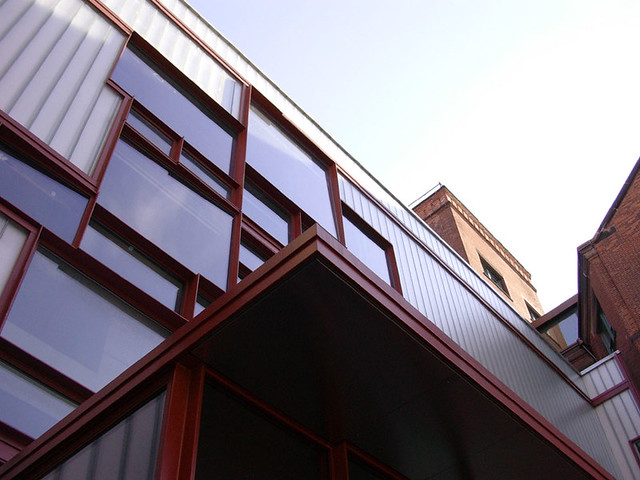Archtober – AIANY's moniker for Architecture and Design Month in October – is nearly upon us. To help in determining where to go and what to see, I've waded through 31 days of lectures/conferences, exhibitions, special events, and buildings of the day to offer my top three recommendations in each area. Even between the printed schedule, below, and the online schedule, there were considerable changes, so it's recommended the you check the Archtober calendar and/or the respective websites for confirmed day/times, and in some cases to register or buy tickets. Happy Archtober!

[Archtober calendar | Photo by John Hill]
SPECIAL EVENTS
Dwell on Design
Archtober 9-11
82 Mercer Street

One of the highlights of Dwell magazine's first East Coast show are the 20 installations created by local designers paired up with manufacturers.
OHNY Weekend
Archtober 11 and 12
Various locations throughout NYC

The full list of sites will be released on September 30, with reservations for certain sites and tours available at ohny.eventbrite.com starting at 11am on October 1.
Architecture and Design Film Festival
Archtober 15-19
Tribeca Cinemas

Highlights in ADFF's sixth season include Wim Wenders's Cathedral of Culture series (3d documentary films by Wenders and other directors) and the world premier of Gray Matters (pictured), a film about Eileen Gray.
EXHIBITIONS
Sagrada Família - Gaudí's Unfinished Masterpiece: Geometry, Construction and Site
Throughout Archtober
Bernard and Anne Spitzer School of Architecture at The City College of New York

City College will also be hosting seven lectures throughout Archtober and November on Gaudí's masterpiece; see the school's website for dates and more information.
New York New Design
Opening Archtober 9
West 4th Street Subway Station

What better place to see the recent work of AIANY architects than in a crowded subway concourse?
Weltstadt – Who Creates the City?
Archtober 1-19
Goethe-Institut Wyoming Building

"The Weltstadt exhibition explores urban participation and the future of cities in light of challenges such as climate change, migration, and social polarization and presents recent initiatives from Bangalore, Belgrade, Curitiba, Dakar, Johannesburg, Lisbon, Madrid, New York, Porto Alegre, Riga, Salvador, São Paulo, Seoul, Toulouse, Turin, and Ulan Bator."
LECTURES/CONFERENCES
Guggenheim Helsinki Competition: Designing a Museum of the Future
Wednesday, Archtober 15 at 6pm
(Location details and link with further information on the panel discussion are still to come.)
Michael Kimmelman and Annabelle Selldorf in Conversation
Thursday, Archtober 16 at 6:30 PM
Higgins Hall Auditorium, Pratt Institute
2014 MAS Summit for New York City
Archtober 23 and 24
TimesCenter
BUILDINGS OF THE DAY
(Visit the Archtober website for registration/tickets.)
Kickstarter, Ole Sondresen
Archtober 7
58 Kent Street, Brooklyn

Glen Oaks Branch Library, Marble Fairbanks
Archtober 11
256-04 Union Turnpike, Queens

Wieden+Kennedy, WORKac
Archtober 14
150 Varick Street

NOT PART OF ARCHTOBER BUT WORTH A MENTION
Critical Halloween: On I-Relevance
October 31
Organized by Storefront for Art and Architecture
Location TBD


[Archtober calendar | Photo by John Hill]
SPECIAL EVENTS
Dwell on Design
Archtober 9-11
82 Mercer Street

One of the highlights of Dwell magazine's first East Coast show are the 20 installations created by local designers paired up with manufacturers.
OHNY Weekend
Archtober 11 and 12
Various locations throughout NYC

The full list of sites will be released on September 30, with reservations for certain sites and tours available at ohny.eventbrite.com starting at 11am on October 1.
Architecture and Design Film Festival
Archtober 15-19
Tribeca Cinemas

Highlights in ADFF's sixth season include Wim Wenders's Cathedral of Culture series (3d documentary films by Wenders and other directors) and the world premier of Gray Matters (pictured), a film about Eileen Gray.
EXHIBITIONS
Sagrada Família - Gaudí's Unfinished Masterpiece: Geometry, Construction and Site
Throughout Archtober
Bernard and Anne Spitzer School of Architecture at The City College of New York

City College will also be hosting seven lectures throughout Archtober and November on Gaudí's masterpiece; see the school's website for dates and more information.
New York New Design
Opening Archtober 9
West 4th Street Subway Station

What better place to see the recent work of AIANY architects than in a crowded subway concourse?
Weltstadt – Who Creates the City?
Archtober 1-19
Goethe-Institut Wyoming Building

"The Weltstadt exhibition explores urban participation and the future of cities in light of challenges such as climate change, migration, and social polarization and presents recent initiatives from Bangalore, Belgrade, Curitiba, Dakar, Johannesburg, Lisbon, Madrid, New York, Porto Alegre, Riga, Salvador, São Paulo, Seoul, Toulouse, Turin, and Ulan Bator."
LECTURES/CONFERENCES
Guggenheim Helsinki Competition: Designing a Museum of the Future
Wednesday, Archtober 15 at 6pm
(Location details and link with further information on the panel discussion are still to come.)
Michael Kimmelman and Annabelle Selldorf in Conversation
Thursday, Archtober 16 at 6:30 PM
Higgins Hall Auditorium, Pratt Institute
2014 MAS Summit for New York City
Archtober 23 and 24
TimesCenter
BUILDINGS OF THE DAY
(Visit the Archtober website for registration/tickets.)
Kickstarter, Ole Sondresen
Archtober 7
58 Kent Street, Brooklyn

Glen Oaks Branch Library, Marble Fairbanks
Archtober 11
256-04 Union Turnpike, Queens

Wieden+Kennedy, WORKac
Archtober 14
150 Varick Street

NOT PART OF ARCHTOBER BUT WORTH A MENTION
Critical Halloween: On I-Relevance
October 31
Organized by Storefront for Art and Architecture
Location TBD




















